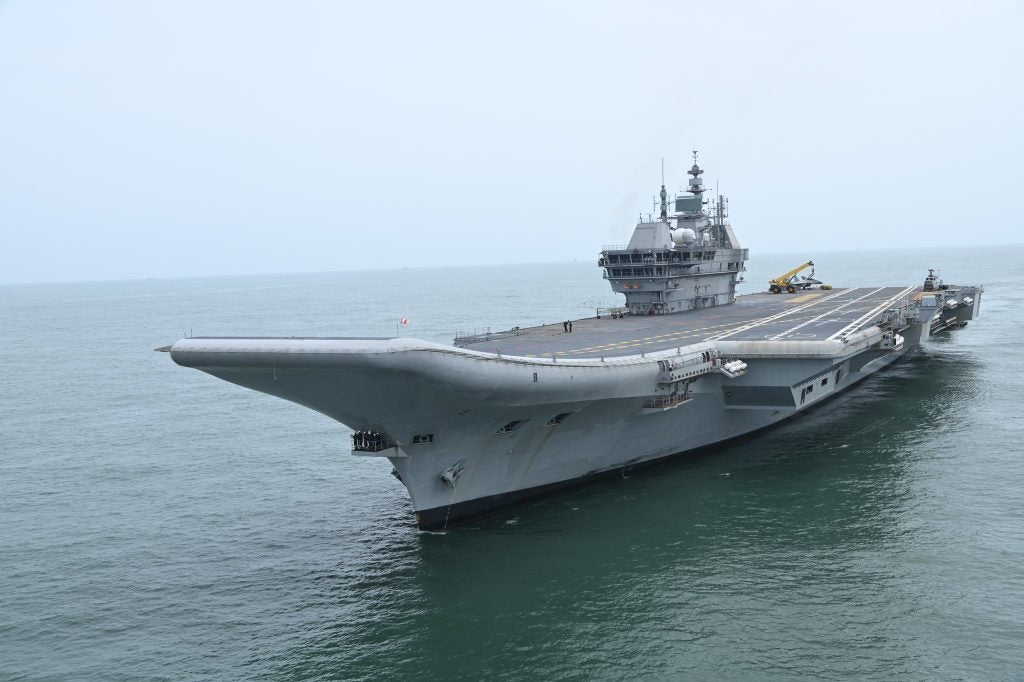India’s First Indigenous Aircraft Carrier INS Vikrant Commissioned Amidst Future Fighter and Carrier Deliberations
Prime Minister Narendra Modi commissioned India’s first indigenous aircraft carrier INS Vikrant (R11) at Cochin Shipyard Limited (CSL) on September 2. INS Vikrant will serve along with INS Vikramaditya (R33) as the Indian Navy’s two operational aircraft carriers until they’re joined by a second indigenous carrier.
India’s efforts to design and build an aircraft carrier dates back to 1979, when DND initially designed a helicopter carrier. But by 1988, DND had turned to a large carrier concept design, capable of operating fixed wing aircraft. France’s DCN was consulted for this ‘Sea Control Ship’ in 1989. By 1990, this had progressed into 25,000 – 40,000 ton concepts with ski jump and catapult variants. CSL was also found suitable to build a carrier during this period.
Smaller 14,000 ton ‘Harrier carriers’ had to be considered in the 1990s due to a financial crisis in 1991. In the late 1990s, a larger Air Defence Ship design was initiated, eventually leading to Indigenous Aircraft Carrier (IAC) Vikrant. Government approval for IAC was provided in 2003 with steel cutting starting by 2005. The keel was laid in 2009 and the ship was launched in 2013.
Time taken for development of indigenous steel due to unavailability of Russian steel, issues with indigenous production of gear components and delays in delivery of aviation complex equipment were among the causes that led to a seven year delay in the induction of Vikrant.
Vikrant has undergone a series of sea trials since 2021. The primary MF-STAR radar has not been installed on the ship yet, along with components of the aviation complex and landing systems. These require installation and testing. INS Vikrant is thus expected to be fully operational and ready for regular deployments by the end of 2023.
INS Vikrant was designed by the Navy’s Directorate of Naval Design Surface Ship Group {DND(SSG)}, now renamed to Warship Design Bureau (WDB). It has a large number of indigenous equipment and machinery. The vessel is 262.5m long with a width and height of 61.6m. The displacement is about 42,800 tons.
The ship is powered by four General Electric LM2500 gas turbines, each generating 22MW. Three diesel alternators generate a total of 24MW. The ship has a maximum speed of over 30 knots and a range of 7500nm at a cruise speed of 18 knots. 32 MRSAM missiles provide protection along with four AK-630 close-in weapon systems.
The ship has a total of 15 decks. Various lifts are provided for transit of equipment and personnel including two aircraft elevators, five ammunition lifts, five passenger lifts and two provision lifts. The carrier will embark 30 aircraft which will be a mix of MiG-29Ks, Ka-31, MH-60R and ALH Dhruv helicopters. The small aircraft elevators, sized 14m x 10m, were designed for the MiG-29K and Naval Light Combat Aircaft (NLCA) variant of the Tejas and may pose issues for the Navy’s future carrier fighters.
Recently, Boeing intensified its pitch of F/A-18 Super Hornets for Indian Navy’s next carrier-based fighter under the Multi Role Carrier Based Fighter (MRCBF) program. 26 fighters will now be bought under this program, down from the 57 indicated initially.
Boeing plans to build on its existing industrial base, comprising over 300 local companies with investments in supply chain development and manufacturing, engineering and technology transfer, long-term support and training, infrastructure investments and contributions of the Hornet Industry Team, who also detailed their commitments to India. Boeing also envisions sharing of technology and transfer work of the F/A-18 fighter jets in India, if viable.
Super Hornets are competing with Dassault Aviation’s Rafale-M for the MRCBF requirement. Both fighters have been tested in India from a Shore Based Test Facility (SBTF) in 2022. However, the 26 MRCBF fighters are a stopgap until the Twin Engine Deck Based Fighter (TEDBF) is developed and inducted.
India’s quest for a third carrier remains in limbo for the time being. Called Indigenous Aircraft Carrier-2 (IAC-2), this is expected to be a 65,000 ton conventional carrier with Integrated Electric Propulsion (IEP). With a larger air wing and elimination of the ski jump in favour of electromagnetic catapults, this carrier would form the basis for Indian Navy’s future carriers replacing INS Vikrant and Vikramaditya.
For more information on INS Vikrant, check out its curtain raiser press conference by the Indian Navy:

